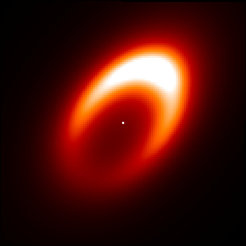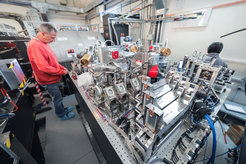Astronomers see whirlwind around possible exoplanet-in-the-making
MATISSE observations of the asymmetrical inner disk of HD 163296
An international team of astronomers led by researchers from the Netherlands and including scientists from the Max-Planck-Institut für Radioastronomie (MPIfR) in Bonn, Germany, has discovered a whirlwind of dust and pebbles in orbit around a young star. It is possible that a planet is forming in the pebbles. The team of scientists made the discovery during the time that designers and developers of an astronomical instrument get as a reward for their work.
Their findings will be published in the journal Astronomy & Astrophysics.

A schematic view of the vortex around the possible exoplanet-in-the-making around the star HD 163296. The bright yellow spot in the upper right indicates an area of warm dust and pebbles where a planet is likely to be formed.
The exoplanet-in-the-making orbits the star HD 163296 in a close orbit. HD 163296 is a young star much studied by astronomers about 330 light-years away from Earth in the constellation of Sagittarius. Previously, astronomers found evidence for the formation of three large exoplanets in a wide orbit around the star. Now, they may be adding a fourth planet close to the star.
The researchers led by Jozsef Varga (Leiden University, The Netherlands) studied the star during four nights in March and June 2019. They had focused their telescope on the inner part of the disk of dust and pebbles that orbit the star. The astronomers observed a ring of warm, fine dust at a distance from the star comparable to Mercury's orbit around our Sun. What was striking was that one part of the ring was much brighter, i.e. hotter, than the rest of the ring. This hot spot seemed to orbit the star in one month.
The astronomers suspect that the hot spot of warm, fine dust is a vortex in the disk from which a planet could be formed. They can support their suspicion with simulations. While in the rest of the disk dust and pebbles clump together, in the vortex the pebbles are actually ground into fine dust. That fine dust is visible in the hot spot.
The researchers made their discovery with the new MATISSE instrument. That instrument combines and analyzes light from four telescopes of the ESO Observatory's Very Large Telescope on Cerro Paranal, in northern Chile. This creates a combined telescope with a virtual diameter of 200 meters. The MATISSE instrument is made especially to analyze infrared radiation. Such radiation is created when an object, such as a planet or dust disk gives off heat. The instrument is cooled to prevent it from emitting infrared radiation itself.
"This first scientific result marks the beginning of further research for our team. One of the goals is to study more stars with dust disks and especially dust disks in which earthlike planets can form", concludes Gerd Weigelt from MPIfR who led a long participation of the institute on MATISSE as head of its Infrared Interferometry research group.
----------------------------------
Additional information:
MATISSE was designed, funded and built in close collaboration with ESO, by a consortium composed of French (INSU-CNRS in Paris and OCA in Nice hosting the P.I. team), German (MPIA, MPIfR and University of Kiel), Dutch (NOVA and University of Leiden), and Austrian (University of Vienna) institutes. The Konkoly Observatory and Cologne University have also provided some support to the manufacture of the instrument.
The research team includes Gerd Weigelt, Karl-Heinz Hofmann, Dieter Schertl, Matthias Heiniger, Udo Beckmann, Claus Connot and Eddy Nußbaum, all affiliated with the Max-Planck-Institut für Radioastronomie.

The MATISSE instrument on ESO’s Very Large Telescope Interferometer (VLTI) during installation. MATISSE uses high-resolution imaging and spectroscopy to probe the regions around young stars where planets are forming as well as the regions around supermassive black holes in the centres of galaxies.

